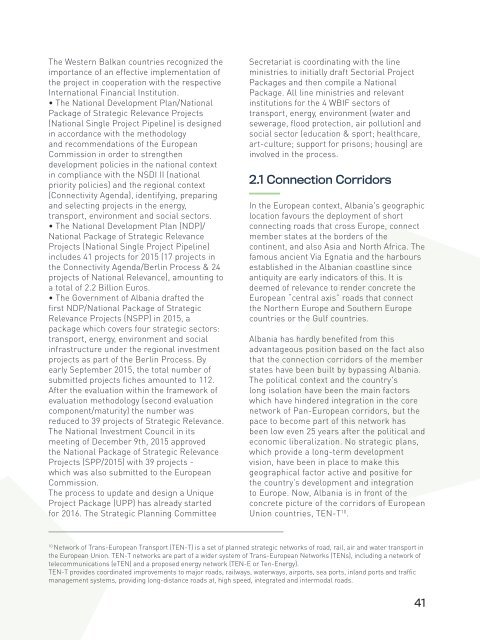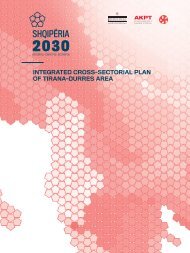General National Spatial Plan / Shqipëria 2030
The General National Spatial Plan (GNSP) provides the strategic reference framework for sustainable territorial development for the next 15 years, in order to ensure balanced economic and social national development, responsible management of natural resources, environmental protection, all while ensuring the rational land use. The GNSP is introduced not only as fulfillment of a legal obligation, but also as a prerequisite to achieving the governmental program objectives to enhance citizens’ welfare and national economic growth by reducing inequalities, strengthening the strategic partnership with neighboring countries and implementation of policies that foster competitiveness of economic sectors, thus ensuring integration in the European Union.
The General National Spatial Plan (GNSP) provides the strategic reference framework for sustainable territorial development for the next 15 years, in order to ensure balanced economic and social national development, responsible management of natural resources, environmental protection, all while ensuring the rational land use. The GNSP is introduced not only as fulfillment of a legal obligation, but also as a prerequisite to achieving the governmental program objectives to enhance citizens’ welfare and national economic growth by reducing inequalities, strengthening the strategic partnership with neighboring countries and implementation of policies that foster competitiveness of economic sectors, thus ensuring integration in the European Union.
Create successful ePaper yourself
Turn your PDF publications into a flip-book with our unique Google optimized e-Paper software.
The Western Balkan countries recognized the<br />
importance of an effective implementation of<br />
the project in cooperation with the respective<br />
International Financial Institution.<br />
• The <strong>National</strong> Development <strong>Plan</strong>/<strong>National</strong><br />
Package of Strategic Relevance Projects<br />
(<strong>National</strong> Single Project Pipeline) is designed<br />
in accordance with the methodology<br />
and recommendations of the European<br />
Commission in order to strengthen<br />
development policies in the national context<br />
in compliance with the NSDI II (national<br />
priority policies) and the regional context<br />
(Connectivity Agenda), identifying, preparing<br />
and selecting projects in the energy,<br />
transport, environment and social sectors.<br />
• The <strong>National</strong> Development <strong>Plan</strong> (NDP)/<br />
<strong>National</strong> Package of Strategic Relevance<br />
Projects (<strong>National</strong> Single Project Pipeline)<br />
includes 41 projects for 2015 (17 projects in<br />
the Connectivity Agenda/Berlin Process & 24<br />
projects of <strong>National</strong> Relevance), amounting to<br />
a total of 2.2 Billion Euros.<br />
• The Government of Albania drafted the<br />
first NDP/<strong>National</strong> Package of Strategic<br />
Relevance Projects (NSPP) in 2015, a<br />
package which covers four strategic sectors:<br />
transport, energy, environment and social<br />
infrastructure under the regional investment<br />
projects as part of the Berlin Process. By<br />
early September 2015, the total number of<br />
submitted projects fiches amounted to 112.<br />
After the evaluation within the framework of<br />
evaluation methodology (second evaluation<br />
component/maturity) the number was<br />
reduced to 39 projects of Strategic Relevance.<br />
The <strong>National</strong> Investment Council in its<br />
meeting of December 9th, 2015 approved<br />
the <strong>National</strong> Package of Strategic Relevance<br />
Projects (SPP/2015) with 39 projects -<br />
which was also submitted to the European<br />
Commission.<br />
The process to update and design a Unique<br />
Project Package (UPP) has already started<br />
for 2016. The Strategic <strong>Plan</strong>ning Committee<br />
Secretariat is coordinating with the line<br />
ministries to initially draft Sectorial Project<br />
Packages and then compile a <strong>National</strong><br />
Package. All line ministries and relevant<br />
institutions for the 4 WBIF sectors of<br />
transport, energy, environment (water and<br />
sewerage, flood protection, air pollution) and<br />
social sector (education & sport; healthcare,<br />
art-culture; support for prisons; housing) are<br />
involved in the process.<br />
2.1 Connection Corridors<br />
In the European context, Albania's geographic<br />
location favours the deployment of short<br />
connecting roads that cross Europe, connect<br />
member states at the borders of the<br />
continent, and also Asia and North Africa. The<br />
famous ancient Via Egnatia and the harbours<br />
established in the Albanian coastline since<br />
antiquity are early indicators of this. It is<br />
deemed of relevance to render concrete the<br />
European “central axis” roads that connect<br />
the Northern Europe and Southern Europe<br />
countries or the Gulf countries.<br />
Albania has hardly benefited from this<br />
advantageous position based on the fact also<br />
that the connection corridors of the member<br />
states have been built by bypassing Albania.<br />
The political context and the country's<br />
long isolation have been the main factors<br />
which have hindered integration in the core<br />
network of Pan-European corridors, but the<br />
pace to become part of this network has<br />
been low even 25 years after the political and<br />
economic liberalization. No strategic plans,<br />
which provide a long-term development<br />
vision, have been in place to make this<br />
geographical factor active and positive for<br />
the country’s development and integration<br />
to Europe. Now, Albania is in front of the<br />
concrete picture of the corridors of European<br />
Union countries, TEN-T 10 .<br />
10<br />
Network of Trans-European Transport (TEN-T) is a set of planned strategic networks of road, rail, air and water transport in<br />
the European Union. TEN-T networks are part of a wider system of Trans-European Networks (TENs), including a network of<br />
telecommunications (eTEN) and a proposed energy network (TEN-E or Ten-Energy).<br />
TEN-T provides coordinated improvements to major roads, railways, waterways, airports, sea ports, inland ports and traffic<br />
management systems, providing long-distance roads at, high speed, integrated and intermodal roads.<br />
41
















